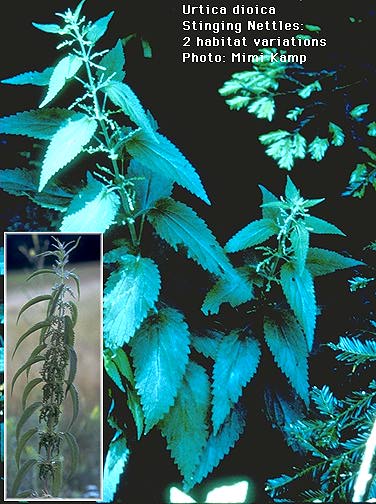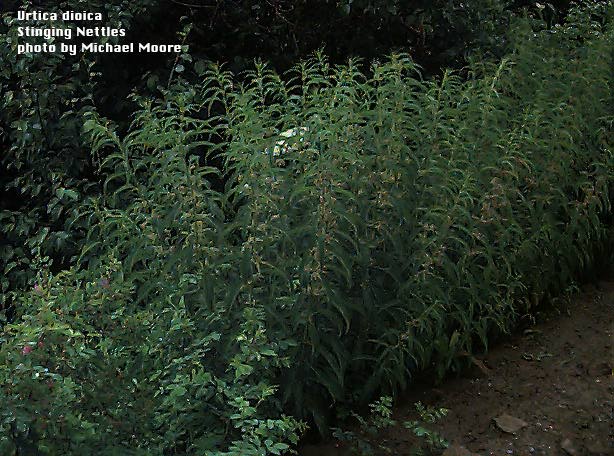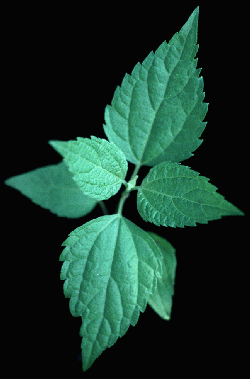
![]()

![]()
Some of our most common and widespread butterflies use plants we consider to be weeds. Have you removed stinging nettles from your yard? The eastern comma (Polygonia comma) and question mark (Polygonia interrogationis), two orange and dark brown anglewing butterflies, choose nettles. The larvae of the Milbert's tortoiseshell (Nymphalis milberti), a two-inch brown butterfly with a bright orange and yellow band, feed communally on nettles. The unmistakable red admiral (Vanessa atalanta), a two-inch brown butterfly with an orange-red band across its wings, feeds on nettles. All these butterflies are wanderers and may find your nettle patch and reproduce. Their colorful wings brighten any yard.
![]()

![]()
STINGING NETTLE WOOD (BULL) NETTLE
Urtica dioica Laportea canadensis
(nettle family)
TOXICITY RATING: Low. Local irritation is the most common sign which shortly resolves on its own.
ANIMALS AFFECTED: Any animal that brushes against or consumes the plant can be affected. Short-haired hunting dogs and other dogs that run through the underbrush are more likely to encounter this plant.
DANGEROUS PARTS OF PLANT: Stems, leaves.
CLASS OF SIGNS: Facial, skin and oral irritation, salivation, pawing at the mouth, possible ocular irritation.
PLANT DESCRIPTION: These herbaceous perennials are common on moist ground in flood plains, woodlands, and along stream and river banks. They often occur in colonies so large that they are the only herbaceous plant present. The tough unbranched stems grow 2 to 5 feet tall from fibrous roots and are covered with stinging bristles. The leaves are opposite, thin, egg-shaped, toothed, and tapered at the tip. They measure 2 to 6 inches by 1 to 2 inches in stinging nettle and 3 to 8 inches by 3 to 5 inches in wood nettle. The 3 to 5 main veins from the base make the leaf (especially in wood nettle) strongly resemble the leaves of white snakeroot. However, the stinging hairs on the lower surface of the leaves prove the plant's identity. The tiny, green or greenish-white flowers droop in axillary clusters in stinging nettle (fig. 31) and stand upright in branching clusters at the top of the stem in wood nettles.
SIGNS: The small, hollow hairs in stinging nettle contain several irritating substances such as histamine (the mediator of some allergic reactions), serotonin, acetylcholine and formic acid (ants contain a high concentration of formic acid). These substances, coupled with the hairs ability to scratch the skin and mucus membranes, results in almost immediate burning, itching and irritation. Typically, signs are present for a few minutes to a few hours, and resolve on their own. If oral contact was made, the animal may shake its head, salivate, and rub its mouth. Skin irritation is possible, especially with short-coated dogs, and ocular (eye) irritation is also possible. It is possible that the animals attempts to comfort itself and relieve the irritation may cause more damage than the plant itself. On very rare occasions (and only after significant amounts were consumed or contacted) will more severe systemic signs manifest (trembling, weakness, disturbances in heart rate). Nearly all animals (including humans) learn to stay away from nettle.
FIRST AID: Limit further exposure as much as possible. Remove affected animals from the areas where the plants are located, and monitor the animals so they don't self-traumatize. Recovery should occur within a few minutes to hours. If animals continue to have difficulty, or if more serious signs develop, or at any time if the eyes are affected, contact a veterinarian.
SAFETY IN PREPARED FEEDS: There is little information on the safety of nettle in feeds. However, due to its irritant potential, inclusion of this plant into hay or feeds is not recommended.
PREVENTION: Use caution in marshy or wooded areas where dense stands of nettle may be located. Prevent animals from contacting the plants as much as possible.
![]()
![]()
Back to Plants
 Wildflower
Seed For Sale
Wildflower
Seed For Sale